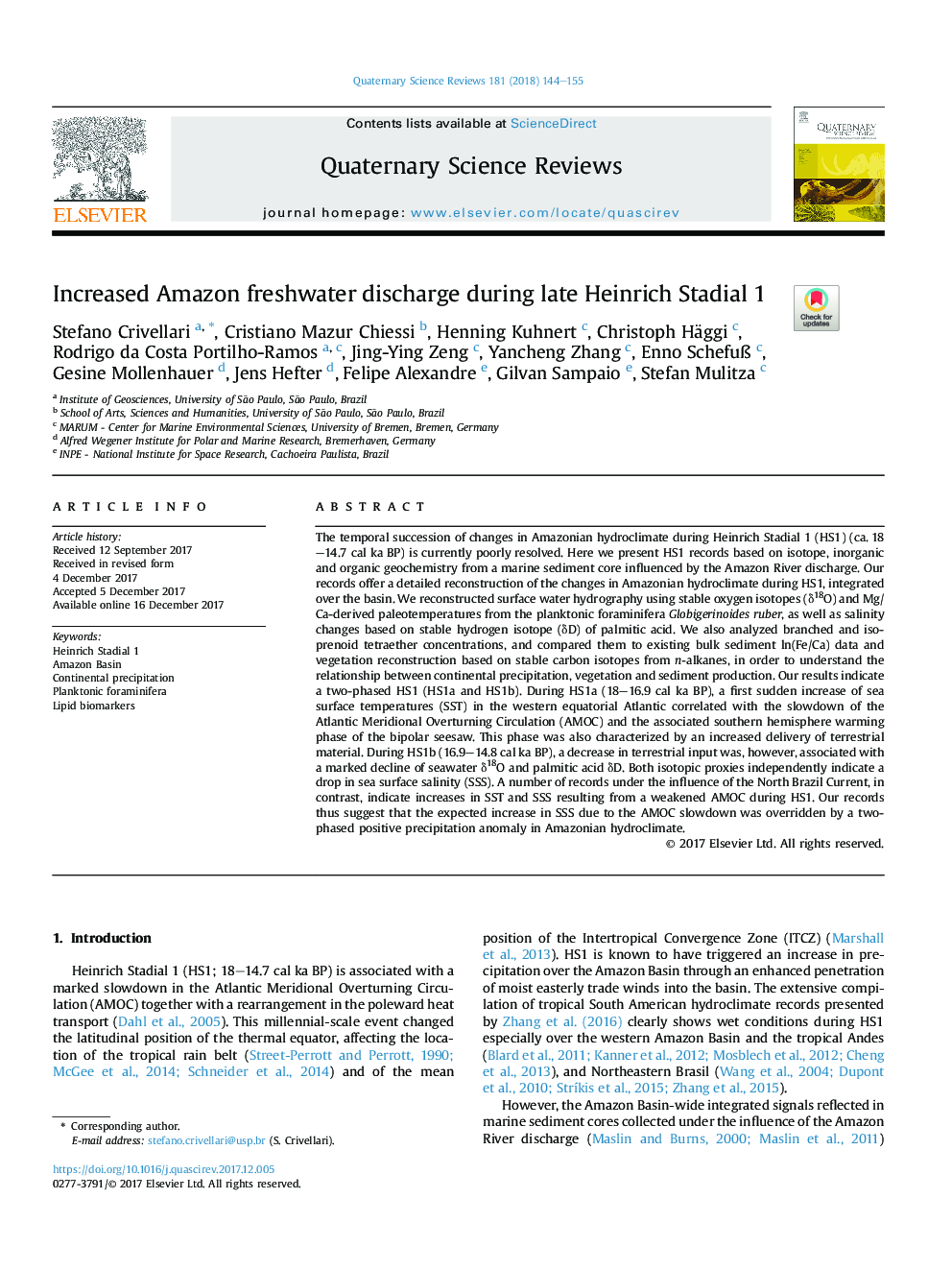| کد مقاله | کد نشریه | سال انتشار | مقاله انگلیسی | نسخه تمام متن |
|---|---|---|---|---|
| 8915017 | 1640754 | 2018 | 12 صفحه PDF | دانلود رایگان |
عنوان انگلیسی مقاله ISI
Increased Amazon freshwater discharge during late Heinrich Stadial 1
ترجمه فارسی عنوان
افزایش آب آشامیدنی آبزی آمازون در اواخر هینریش استادیال 1
دانلود مقاله + سفارش ترجمه
دانلود مقاله ISI انگلیسی
رایگان برای ایرانیان
کلمات کلیدی
هاینریش استادیال 1، حوضه آمازون، بارش قاره ای، فورنینیفور پلانکتونی، بیومارکرهای لیپید،
موضوعات مرتبط
مهندسی و علوم پایه
علوم زمین و سیارات
زمین شناسی
چکیده انگلیسی
The temporal succession of changes in Amazonian hydroclimate during Heinrich Stadial 1 (HS1) (ca. 18-14.7 cal ka BP) is currently poorly resolved. Here we present HS1 records based on isotope, inorganic and organic geochemistry from a marine sediment core influenced by the Amazon River discharge. Our records offer a detailed reconstruction of the changes in Amazonian hydroclimate during HS1, integrated over the basin. We reconstructed surface water hydrography using stable oxygen isotopes (δ18O) and Mg/Ca-derived paleotemperatures from the planktonic foraminifera Globigerinoides ruber, as well as salinity changes based on stable hydrogen isotope (δD) of palmitic acid. We also analyzed branched and isoprenoid tetraether concentrations, and compared them to existing bulk sediment ln(Fe/Ca) data and vegetation reconstruction based on stable carbon isotopes from n-alkanes, in order to understand the relationship between continental precipitation, vegetation and sediment production. Our results indicate a two-phased HS1 (HS1a and HS1b). During HS1a (18-16.9 cal ka BP), a first sudden increase of sea surface temperatures (SST) in the western equatorial Atlantic correlated with the slowdown of the Atlantic Meridional Overturning Circulation (AMOC) and the associated southern hemisphere warming phase of the bipolar seesaw. This phase was also characterized by an increased delivery of terrestrial material. During HS1b (16.9-14.8 cal ka BP), a decrease in terrestrial input was, however, associated with a marked decline of seawater δ18O and palmitic acid δD. Both isotopic proxies independently indicate a drop in sea surface salinity (SSS). A number of records under the influence of the North Brazil Current, in contrast, indicate increases in SST and SSS resulting from a weakened AMOC during HS1. Our records thus suggest that the expected increase in SSS due to the AMOC slowdown was overridden by a two-phased positive precipitation anomaly in Amazonian hydroclimate.
ناشر
Database: Elsevier - ScienceDirect (ساینس دایرکت)
Journal: Quaternary Science Reviews - Volume 181, 1 February 2018, Pages 144-155
Journal: Quaternary Science Reviews - Volume 181, 1 February 2018, Pages 144-155
نویسندگان
Stefano Crivellari, Cristiano Mazur Chiessi, Henning Kuhnert, Christoph Häggi, Rodrigo da Costa Portilho-Ramos, Jing-Ying Zeng, Yancheng Zhang, Enno SchefuÃ, Gesine Mollenhauer, Jens Hefter, Felipe Alexandre, Gilvan Sampaio, Stefan Mulitza,
